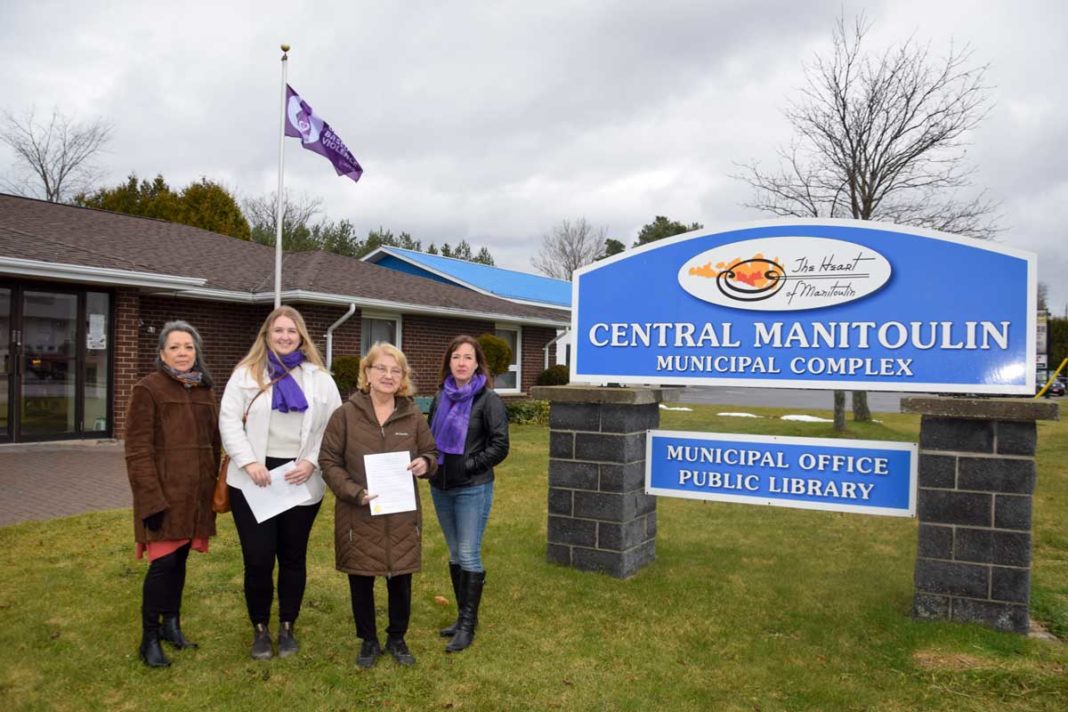CENTRAL MANITOULIN—Manitoulin Family Resources (MFR) staff joined a representative of UCCM Anishinaabe Police Services and Central Manitoulin CAO Ruth Frawley in raising a flag on the lawn of the municipal offices in Mindemoya on November 25 to kick off International Day to End Gender-Based Violence and the Purple Scarf Campaign.
“We are here today to raise a flag on the day of International Day to End Gender-Based Violence and the start of 16 days of Remembrance,” said Marissa McCready, shelter supervisor at MFR’s Haven House. “November is Gender-based Violence Prevention Month and the launch of the Wrapped in Courage Campaign.”
This is the 10th anniversary of Ontario’s Wrapped in Courage Campaign and gender-based violence agencies across Ontario are asking leaders and community members to wear a purple scarf to show their commitment to ending femicide and all forms of gender-based violence.
A purple scarf symbolizes the courage needed by communities to support survivors of violence, the commitment to turn awareness into accountability and action and to ultimately end gender-based violence.
Gender-based violence is too often an invisible issue and many women and gender-diverse individuals may not be aware of the services that are available in their community, noted Ms. McCready who pointed out that everyone has a key role to play when it comes to addressing gender-based violence and preventing femicide.
Ms. McCready explained that gender-based violence may often be hidden, but it is far from invisible to the families and friends of the 52 women and girls who lost their lives in Ontario over the past year to femicide. November 25 marks International Day for the Elimination of Violence Against Women and the first day of the 16 Days of Activism to End Gender-Based Violence—an opportunity to challenge the longstanding complacency towards inequality, to remember the lives taken and to recognize the lasting impact of these losses on communities and families.
Over the years since the Ontario Association of Interval and Transition Houses (OAITH) began collating statistics they have identified 980 victims of femicide who have lost their lives to gender-based violence. That label may be non-gender specific, but the sad truth is that all of those deaths were perpetrated by men, and usually men who knew the victim.
“As we release our annual femicide list highlighting 52 femicides in 52 weeks, we are urging all Ontarians, elected officials and those working in systems and services to do their part by prioritizing the safety of survivors, so they don’t end up on our femicide list,” said Marlene Ham, executive director of OAITH in a release. “Ultimately, these rates reflect larger systemic issues and conditions that have led to tragic outcomes.”
Ms. Ham notes that if those issues are not addressed, Ontario will continue on a trajectory that doesn’t prioritize or value the safety concerns for survivors of gender-based violence. “Femicide prevention is a non-partisan issue which must be the priority of every leader and all levels of government across our province,” she said.
Ms. McCready provided an alarming snapshot of trends contained within the 2021-2022 Annual Femicide List. There were 19 intimate partner femicides (37 percent), 11 perpetrated by family members (21 percent), eight femicides perpetrated by men known to the victim (15 percent) and 14 femicide cases (27 percent) where the relationship was not provided but where evidence suggests the victims were targeted. Of those murders, 77 percent occurred either inside or near a residence, highlighting the need for access to safe, affordable housing.
Age and location are not bulwarks against becoming a victim, with Ontario victims ranging in age from eight to 88 this year and those over the age of 55 represent 21 percent of victims and 17 percent were murdered in rural or small population centres. OAITH notes that those experiencing violence in rural settings often face additional barriers in accessing support, including transportation, physical and social isolation, limited services and access to housing, a lack of anonymity and responsibility of caring for livestock.
The plight of Missing and Murdered Indigenous Women and Girls has not abated. Although Indigenous females make up 2.8 percent of Ontario’s population, they account for four percent of the victims.
Women of colour make up 4.7 percent of Ontario’s population, yet they account for eight percent of the victims in the 2021-2022 data.
OAITH notes that racialized women experiencing violence have diverse, unique needs that are often overlooked in research leading to shortfalls in policymaking and practice.
Flags acknowledging the Wrapped in Courage Campaign are being raised in communities across Manitoulin Island over the next couple of weeks.
“As you leave here today, look up to that purple flag in the sky,” said Ms. McCready. “This flag is a symbol of our movement. Although the winds may try to knock it down, our message will not be suppressed, we remain strong. In our fight to end violence against women be loud, be obnoxious, and be persistent. Let’s come together as a community and let’s end gender-based violence.”
Please see One Manitowaning Road for an op-ed by Ms. Hall on this topic.





